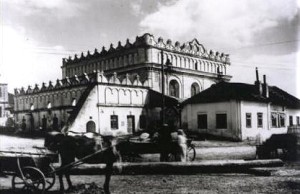 Northwestern view of the Great Synagogue, with shtiblekh (small prayer houses) at right, ca. 1930. Collection of Polska Akademia Nauk, Instytut Sztuki |
|
|
Remembering Luboml - Images of a Jewish Community |
|
The Virtual Exhibit - 2001 |
|
The exhibition Remembering Luboml: Images of a Jewish
Community offers a poignant glimpse of daily life in a shtetl representative of
many others which were destroyed in World War II. The exhibition is a photo
essay of archival prints and artifacts that re-create life between the wars in the
Polish shtetl of Luboml (Libivne in Yiddish). The exhibition is the culmination of
three years of intense research and gathering of archival photographs, original
films from the 1930s and interviews with Libivners and precision design for a
traveling installation. |
|
|
 Northwestern view of the Great Synagogue, with shtiblekh (small prayer houses) at right, ca. 1930. Collection of Polska Akademia Nauk, Instytut Sztuki |
|
|
|
| The Jewish community of Luboml dated back to the 14th century.
By the 1930s, Libivne (as it was called in Yiddish) had a vibrant community
of at least 4,000 Jews. The interwar years were a period of astonishing
cultural ferment and change in this Polish shtetl. While the family and
traditional religious institutions continued to play a central role, they
were joined and sometimes challenged by modern intellectual attitudes,
styles of dress, and other secular influences (particularly Zionism) which
increasingly made their way to this corner of eastern Europe. Luboml was occupied by the Soviets from 1939 until 1941, when the Germans took control and established a ghetto there. Ultimately, the Germans, assisted by Ukrainians and Poles, massacred the Libivner Jews in a series of "actions" which culminated in the final executions on October 1, 1942. Only 51 Luboml Jews (excluding those who had emigrated before the war) are believed to have survived the Holocaust. The Luboml Exhibition Project has located almost 2,000 photographs and artifacts from more than 100 families and archives around the world, and has taped many video interviews with Libivners. We are pleased to present a small part of our collection online. |
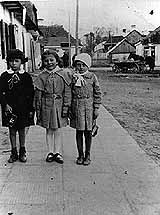 Right to left: Roza Szwarc, Rivke Milshtein and an unidentified girl. 1937. Collection of Fruma Golod "To me, Luboml was and will forever remain -- Libivne!" |
|
|
| "The area of the market place was divided up into various, definite sections: the southeastern corner for the horse auction, and the section nearby for cows; on its northern section, pigs and stands for selling pork and other products; and the northwestern section, for shoes, clothing, furs, hats, and other furnishings. The noise was deafening; voices of vendors and buyers, mooing of cows, whinnying of horses, snorting of pigs -- all these filled the area of the marketplace, which bustled and hummed without let-up until the late afternoon." Yisrael Garmi |
|
|
Market day in the marketplace, 1926 |
|
|
 |
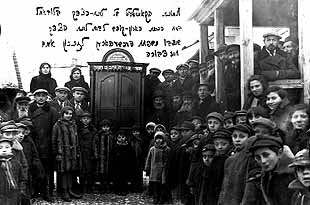 |
| The Milshtein brothers (in doorway) with employees of their shoemaking business, ca. 1920. Collection of Alexander Ostapyuk. |
Townspeople posing with Torah Ark donated to the Lines-Hatsedek Synagogue by the Gershengorn family in memory of their mother Khaye Devoyre, 1930s. Collection of Heichal Yahaduth Wolyn. |
|
|
|
Artifacts
from Luboml |
|
|
| My
dear beloved Arele and Lybule! I can in no way make peace with the idea
that you, my dear ones, are going away. Because until now it seemed like
only a fantasy to me. But I see that reality is stronger and that a higher
authority wished it so...so travel in good health, arrive in peace, be
successful throughout life. I expect to hear good tidings from you. Be
proud, religious, nationalist Jews. Your uncle, Joseph Zygielman Entry in homemade autograph book given to Esther Zygielman and her children Aaron and Luba, upon their departure from Luboml for New York, 1938. |
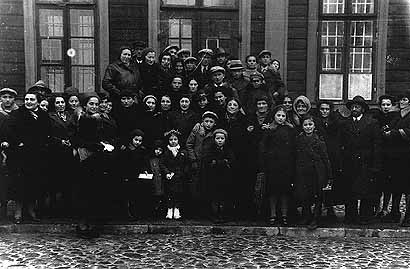 |
| Farewell portrait of friends and family at the Luboml railroad
station. 1938 Collection of Lillian Ziegelman Chanales Taken on the occasion of the departure of the Zygielman family for America. Aaron Zygielman (front row, near center, with white cap), Aaron's mother Esther (behind him wearing a hat), and sister Luba (standing, 8th from right). |
|
|
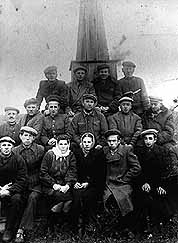 |
"I returned to Libivne on June 22, 1944...Not a stone was
left of the Besmedresh (the study house). A place that had
served its holy task for hundreds of years; where for hundreds of years
Yiddish was heard; where many generations of Jews would gather to pray
to God -- it now lay in ruins. Thorns and wild grass had covered it." Chaim Rozenblitz |
| Survivors at an early monument to Holocaust victims in Luboml., ca. 1945. Collection of Nathan Sobel. |
|
|
|
The Luboml Exhibition Project was initiated in 1994 by Aaron Ziegelman, a Libivner who emigrated to the United States in 1938. To date, the Project has located almost 2,000 photographs and artifacts from more than 100 families and archives around the world, and has taped many video interviews with Libivners. The Luboml Exhibition Project is underwritten by the Aaron Ziegelman Foundation. |
All quotations are translated from
the Yizkor Book of Luboml (Tel Aviv, 1975),
unless otherwise indicated.
Top of Page Virtual Exhibit Luboml Home Page
Pages created by Arnold Berger